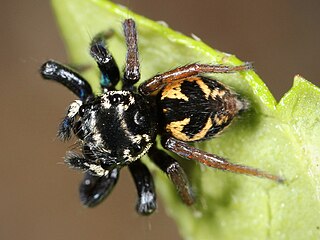
Agobardus is a genus of jumping spiders that was first described by Eugen von Keyserling in 1885.

Anasaitis is a genus of jumping spiders that was first described by E. B. Bryant in 1950. The name is derived from the salticid genus Saitis.
Antillattus is a genus of Caribbean jumping spiders that was first described by E. B. Bryant in 1943. The name is a combination of "Antilles" and the common ending for salticid genera -attus.
Compsodecta is a genus of Caribbean jumping spiders that was first described by Eugène Louis Simon in 1903.

Corythalia is a genus of jumping spiders that was first described by Carl Ludwig Koch in 1850.
Sidusa is a genus of jumping spiders that was first described by George and Elizabeth Peckham in 1895.

Euophryini is a tribe of jumping spiders. It has also been treated as the subfamily Euophryinae.
Chalcolemia is a monotypic genus of jumping spiders containing the single species, Chalcolemia nakanai. It was first described by J. X. Zhang & Wayne Paul Maddison in 2012, and is only found on New Britain.
Chinophrys is a genus of jumping spiders that was first described by J. X. Zhang & Wayne Paul Maddison in 2012.
Corticattus is a genus of Caribbean jumping spiders that was first described by J. X. Zhang & Wayne Paul Maddison in 2012. As of June 2019 it contains only two species, found only on Hispaniola and in Puerto Rico: C. guajataca and C. latus.

Ecuadattus is a genus of Ecuadorian jumping spiders that was first described by J. X. Zhang & Wayne Paul Maddison in 2012.
Foliabitus is a genus of Asian jumping spiders that was first described by J. X. Zhang & Wayne Paul Maddison in 2012. As of June 2019 it contains only two species, found only in Asia: F. longzhou and F. scutigerus.
Parabathippus is a genus of Southeast Asian jumping spiders that was first described by J. X. Zhang & Wayne Paul Maddison in 2012.
Parvattus is a monotypic genus of Chinese jumping spiders containing the single species, Parvattus zhui. It was first described by J. X. Zhang & Wayne Paul Maddison in 2012, and is only found in China.
Phasmolia is a monotypic genus of Papuan jumping spiders containing the single species, Phasmolia elegans. It was first described by J. X. Zhang & Wayne Paul Maddison in 2012, and is only found in Papua New Guinea.
Popcornella is a genus of Caribbean jumping spiders that was first described by J. X. Zhang & Wayne Paul Maddison in 2012.
Variratina is a monotypic genus of Papuan jumping spiders containing the single species, Variratina minuta. It was first described by J. X. Zhang & Wayne Paul Maddison in 2012, and is found in Papua New Guinea.
Viribestus is a monotypic genus of Papuan jumping spiders containing the single species, Viribestus suyanensis. It was first described by J. X. Zhang & Wayne Paul Maddison in 2012, and is found in Papua New Guinea.
Zabkattus is a genus of Papuan jumping spiders that was first described by J. X. Zhang & Wayne Paul Maddison in 2012.




